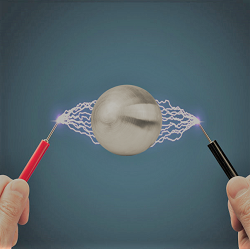Objects at a very small scale behave very differently from large ones. If we take a piece of gold, with the bright yellow hue that we all find so attractive, and make it smaller and smaller, we end up with a material whose colour can be red or even green if we illuminate it the right way.
This strange phenomenon has been used for over a thousand years by experienced artisans, who have given us some of the beautiful stained glass artwork we find in ancient cathedrals and many museums around the world. While in the past centuries such artwork was the result of jealously kept recipes of grounded minerals and other ingredients, today we understand the science behind it. When the size of a piece of metal is reduced down to the nanoscale, which means we have a metallic nanoparticle about 1000 times smaller than the thickness of a strand of hair, its interaction with light changes completely. The electrons of the metal, which are the part of the material that interacts with light, are confined to such a small space that they respond to the electromagnetic field by oscillating all together from one side of the nanoparticle to the other. The result is that these charge oscillations interact with light again, producing an electromagnetic field whose frequency depends on the size and shape of the nanoparticle.
As the interaction between light and nanoparticles is due to the charges inside the metal, we decided to alter the system by applying an external voltage to the particle. The idea was to bring in external charges and change the interaction, and we wanted to explore the effects this would have on light. Unfortunately, with particles this small, electrical connections can’t be made by attaching a simple wire. We needed to scale down the contact to a size closer to the nanoparticle, and also make it flexible and stable enough to wrap the particle and keep it still. After trying several materials, we decided to go for a very thin sheet (single layer) of carbon atoms: graphene. This material that we laid on top of the nanoparticles like a conductive carpet, has extraordinary mechanical and electrical properties. By fabricating an external electrical bridge with the graphene, we therefore created an indirect contact with the nanoparticle.
We are now testing our new devices, and hope to be soon able to answer our original question: is it really possible to electrically contact a nanoparticle?
Dean Kos
NanoDTC PhD Associate 2015
Department of Physics

